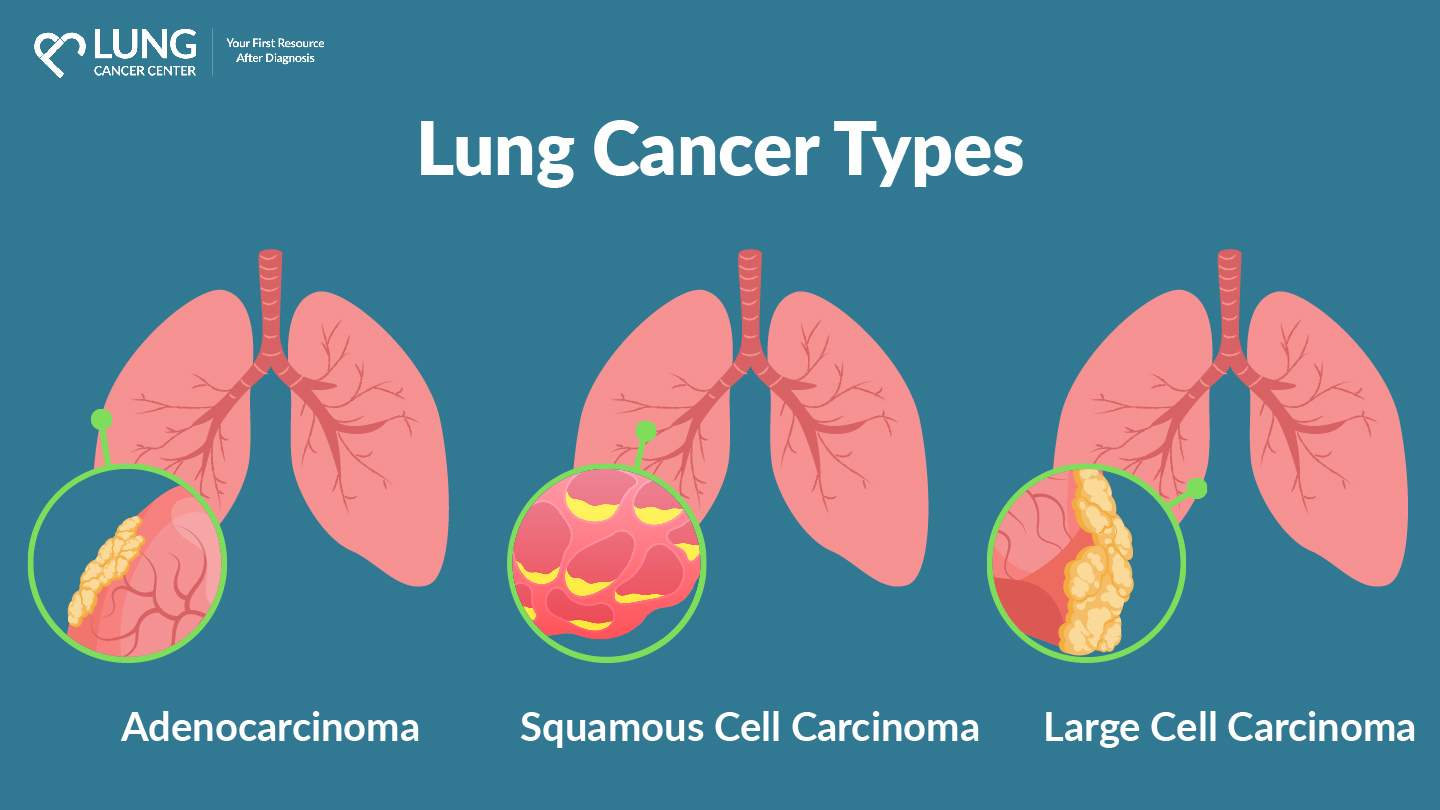Lung Cancer Types
Lung cancer is a disease affecting millions globally that occurs as a result of the uncontrolled growth of irregular cells in the lung tissue. If you develop lung cancer, you may experience coughing, chest pain, and breathing difficulties.


How Different Types of Lung Cancer Affect You
As a person with lung cancer, you should be aware that there are various lung cancer types, each potentially requiring different treatment approaches. Navigating your distinct lung cancer type requires some understanding of the distinctions between the types and their respective treatments.
Your lungs are vital organs responsible for breathing and are divided into lobes: the right lung has three lobes, and the left has two. Air enters through the windpipe (trachea) and then branches into tubes called bronchi, which further divide into smaller bronchioles. These bronchioles end in tiny air sacs called alveoli, where oxygen and carbon dioxide exchange occurs. Lung cancer starts in the cells lining these airways or the alveoli, interfering with normal lung function.
As the disease progresses, cancerous cells may grow and spread within the lung tissues, potentially obstructing airways, impairing lung tissue elasticity, and reducing gas exchange in the alveoli. This disruption can lead to various symptoms, impacting overall respiratory function and health. In this article, we will explore the different types of lung cancer, their treatment options, and how you can seek legal compensation if you were exposed. This is not medical advice so please consult with a doctor before pursuing any treatment.
What are the Main Types of Lung Cancer?
The main lung cancer types are non-small cell lung cancer (NSCLC) and small cell lung cancer (SCLC). NSCLC is the most common type, making up lung cancer cases. It includes several subtypes, such as adenocarcinoma, squamous cell carcinoma, and large cell carcinoma. NSCLC usually grows and spreads slower than small-cell lung cancer.
In comparison, SCLC makes up about 10-15% of lung cancer types of cases. It is aggressive and tends to spread faster. It is often diagnosed in more advanced stages, but typically responds well to chemotherapy and radiation therapy treatments.
Lung cancer types can be classified based on how its cells appear under a microscope or by specific genes or proteins. Understanding the lung cancer type and its characteristics helps your care team develop an effective and personalized treatment plan specific to your needs.
Non-Small Cell Lung Cancer (NSCLC)
Most patients with this lung cancer type have non-small cell lung cancer (NSCLC). NSCLC is further classified into several subtypes with distinct characteristics and treatment options. The three main types of NSCLC are Lung adenocarcinoma, Squamous cell lung cancer (epidermoid carcinoma), and Large cell lung cancer.
- Adenocarcinoma – Also known as ADC, adenocarcinoma involves tumors developing in cells that secrete mucus-like substances. More specifically, the tumors begin in the glands that line the inside of your lungs. Adenocarcinoma is the most common subtype of NSCLC, accounting for about 40% of cases. Lung adenocarcinoma typically develops in the outer regions of the lungs and if often found in non-smokers or former smokers.
- Squamous cell carcinoma – Tumors begin in squamous or flat cells, and line the inside of the lung airways. Squamous cell carcinoma is commonly linked to a history of smoking, as tumors are usually found in the central part of the lungs near a primary airway. Squamous cell lung cancer makes up between 25-30% of cases. This type of NSCLC can form in the central airways of your lungs, causing symptoms like coughing up blood and chest pain.
- Large cell carcinoma – This lung cancer type is also undifferentiated, meaning that it can be located anywhere in the lung. Also, it develops more quickly than the other subtypes, making it more challenging to treat. Large cell neuroendocrine carcinoma is a subtype of large cell carcinoma that also develops quickly but is more similar to small cell lung cancer. Large cell carcinoma is a less common subtype, making up about 10-15% of NSCLC cases. This form of lung cancer causes large, abnormal-looking cells to develop in any part of your lungs. It tends to grow and advance rapidly.
- Adenosquamous carcinoma – This form of lung cancer contains at least 20% of components from lung adenocarcinoma and squamous cell carcinoma. Additionally, it is extremely rare and tough to diagnose preoperatively.
- Sarcomatoid carcinoma – A mixture of carcinoma (skin or tissue cancer) and sarcoma (a cancer of the bone, cartilage, fat, muscle, blood vessels, or other connecting or supporting tissues.)
Small Cell Lung Cancer (SCLC)
Small cell lung cancer (SCLC), although less common than NSCLC, is a highly aggressive type of lung cancer. Patients with SCLC are typically current or former cigarette smokers. There are two subtypes of SCLC called oat (small) cell carcinoma and combined small cell carcinoma. When viewed under a microscope, small cell carcinoma looks like small, oat-shaped cells.
These cells tend to grow and spread fast. Small cell carcinoma cells can be combined with other lung cancer types, such as NSCLC. The presence of different cell types within the tumor can affect its behavior, response to treatment, and overall prognosis. They differ in how they grow, metastasize, and how they appear when observed through a microscope.
The development of SCLC is grouped into two stages: limited and extensive. During the limited phase, tumors have only developed in one lung and possibly the lymph nodes on one side of the chest. The extensive stage occurs when tumors metastasize from one lung to another, the lymph nodes, and possibly even other organs.
While limited-stage SCLC patients may have more treatment options to cure the disease, treatments for extensive-stage SCLC patients are more focused on relieving symptoms or slowing the disease down, otherwise known as palliative treatments.
Rare Types of Lung Cancer and Lung-Related Diseases
In addition to NSCLC and SCLC, several less common subtypes of lung-related diseases can affect you. These cancers can include carcinoid tumors and mesothelioma. Non-cancerous lung conditions like pulmonary fibrosis, bronchiectasis, and chronic obstructive pulmonary disease (COPD) can cause significant respiratory impairment and require treatment. In general, they are rare and typically mentioned case-by-case as they occur.
Mesothelioma and Asbestosis
Mesothelioma is a rare form of cancer that primarily affects the lining of the lungs (pleura). Still, it can also occur in the lining of the abdomen (peritoneum), heart (pericardium), or testicles. The primary cause of mesothelioma is exposure to asbestos, a mineral once widely used in construction, insulation, and other industries. Recently, the most commonly used form of asbestos was banned, but time will tell how it affects future exposure rates.
Inhalation or ingestion of asbestos fibers can lead to the accumulation of these fibers in the body, causing inflammation and scarring over many years. Eventually, this can lead to the development of mesothelioma. Symptoms of mesothelioma, including chest pain, shortness of breath, coughing, fatigue, and unintended weight loss, may not appear until decades after asbestos exposure.
Mesothelioma is often diagnosed at an advanced stage, making it challenging to treat. However, treatment options such as surgery, chemotherapy, radiation therapy, and emerging therapies like immunotherapy may help improve outcomes and help you manage symptoms.
Asbestosis is a chronic lung disease caused by asbestos exposure. Unlike mesothelioma, asbestosis is a non-cancerous condition characterized by scarring of lung tissues (fibrosis). Similar to lung cancer, symptoms of asbestosis include shortness of breath, persistent cough, chest tightness or pain, and swelling of the fingers.
Lung Carcinoid Tumors
Lung carcinoid tumors are rare growths that develop in the lung’s neuroendocrine cells. Unlike more common types of lung cancer, lung carcinoid tumors tend to grow slowly and are less aggressive. It is not uncommon to come across these tumors during tests for other health issues. If they grow large enough, they can cause coughing, wheezing, chest pain, or trouble breathing. Treatment for lung carcinoid tumors usually involves surgery to remove the tumor and additional treatments like radiation or chemotherapy.
Pancoast Lung Tumors
Pancoast lung tumors are a specific type of rare lung cancer that grow near the top of your lungs, right next to the nerves in your chest. Named after the physician who first described them in the early 20th century, Pancoast tumors are usually classified as a subtype of NSCLC, though they can also be SCLC. Because of their location, they can cause some unique problems. You might feel severe pain, weakness, or a tingly sensation in your shoulder, arm, or chest.
Since Pancoast tumors can press on nearby nerves, you may find it hard to move your arm or shoulder normally. This condition can also cause Horner’s syndrome, which causes a drooping eyelid and decreased sweating on one side of the face.
Lung Cancer in Non-Smokers
Whether you smoke or not, lung cancer can happen to anyone. It is not always clear what causes it, but researchers have linked lung cancer in non-smokers to exposure to things like secondhand smoke, radon gas, or pollution. Genetic factors and family history may also play a role in some cases. Other potential risk factors that may increase your risk for lung cancer include pre-existing lung conditions like COPD or tuberculosis. While smoking remains the leading cause of smoker’s lung and lung cancer, everyone should be aware of potential symptoms and screening options.
Other Rare Types of Lung-Related Diseases
- Cystic carcinomas – Normally cancer that begins in the glandular tissues of the head and neck, cystic carcinoma is uncommon and can sometimes occur in other parts of the body.
- Lymphomas – When tumors develop in the infection-fighting cells of the immune system, otherwise known as lymphocytes, lymphomas form. This includes cells in the lymph nodes, spleen, thymus, bone marrow, and others.
- Sarcomas – Another general term for a broad group of cancers that begin in the bones and soft tissues, sarcomas can occur in multiple locations in the body. There are over 70 different types of sarcomas.
- Hamartomas – Noncancerous tumors are made of an irregular mixture of healthy tissues and cells. Hamartomas can grow on any external part of the body and internally in places such as the lungs.
Treatments for Types of Lung Cancer
Knowing your treatment options can give you a sense of control over your cancer journey and better equip you to face lung cancer head-on. When you understand what treatments are available, you can work with your doctors to choose the best plan for you and know what to expect from each treatment, including any potential side effects or risks. The type of lung cancer you have can make a big difference in your treatment plan. Each type of lung cancer behaves differently and may respond differently to treatments.
Non-Small Cell Lung Cancer (NSCLC) Treatment
When it comes to treating non-small cell lung cancer, several options are available to you. Surgery is a common treatment for NSCLC. It involves removing the cancerous tumor from your lung to help you breathe easier and fight the cancer directly. Chemotherapy is another important treatment for NSCLC and involves the use of drugs to kill cancer cells anywhere in your body. Another option is radiation therapy, which uses high-energy rays to target and destroy cancer cells. Your treatment team will help you decide which treatments are best for you based on your specific situation.
Small Cell Lung Cancer (SCLC) Treatment
Treatment options for small cell lung cancer include chemotherapy and radiation therapy, sometimes used together for better outcomes. With a SCLC five-year survival rate ranging from 6% to 12%, starting lung cancer treatment as soon as possible can make a big difference in your prognosis. SCLC can be aggressive, but with treatment, many patients see improvements in symptoms and quality of life.
Lung Carcinoid Tumors Treatment
The treatment approach for lung carcinoid tumors differs for each patient. As a lung carcinoid tumor patient, you will undergo treatments based on factors like tumor size, location, and whether the disease has spread. Surgery is a common primary treatment, where doctors remove the tumor and any affected tissue. For larger tumors or more advanced cases, treatments can include chemotherapy or radiation therapy to attack cancer cells.
Lung carcinoid tumors tend to grow slowly and have a more favorable prognosis compared to other lung diseases. The five-year survival rate for lung carcinoid tumors can be as high as 90% when cancer hasn’t spread beyond the lung.
Pancoast Lung Tumors Treatment
Treating Pancoast lung tumors can be challenging due to their location near important nerves in the chest. Because Pancoast tumors are often diagnosed at advanced stages, survival rates can be more challenging. Treatment options are limited to chemotherapy, radiation therapy, and sometimes surgery. For cases that are not as severe, people tend to have a good chance of surviving for five years or more. On average, about 30% to 50% of people with this type of cancer reach the five-year survival mark.
Mesothelioma and Asbestosis Treatment
Mesothelioma patients typically undergo a combination of treatments, including surgery, chemotherapy, and radiation therapy. Because it is usually diagnosed in later stages, treatment can be challenging. Asbestosis treatment focuses more on managing symptoms and preventing further damage. Both conditions require close monitoring by experienced healthcare professionals.
The five-year survival rate for mesothelioma ranges from around 10% to 20%, with a life expectancy averaging between 12 to 21 months. Asbestosis, while not a form of cancer, can lead to respiratory complications and a decreased quality of life. As a patient with asbestosis, it is important to seek care early to help manage symptoms and improve your outcome. Despite the challenges, staying informed about the best lung cancer hospitals and treatment options can make a big difference.
Understanding Lung Cancer Staging for Treatment
Understanding lung cancer staging is important because it helps your doctors determine the best treatment plan for you. Staging tells us how far the cancer has spread in your body and helps predict how cancer might behave going forward. Typically, lung cancer is staged from stage 0 to stage IV, with stage 0 being the earliest stage and stage IV being the most advanced. The lower the stage, the less the cancer has spread, and the better the chances for successful treatment.
Once your doctors know the stage of your lung cancer type, they can come up with the most effective plan. If your cancer is at an early stage, surgery might be the best option to remove the tumor. More advanced cases involve treatments that help shrink the cancer and manage symptoms. Generally, the earlier the stage, the better the chances for successful treatment and a longer life expectancy. But no matter what stage you are at, support is available.
Lung Cancer Recurrence and Metastasis
Although no one wants to hear about lung cancer recurrence and metastasis, they are important to understand. Lung cancer recurrence means the cancer comes back after treatment, and metastasis means it spreads to other parts of your body. While both of these seem alarming, there are ways to manage them.
If your lung cancer comes back, you will work with your medical team to come up with a new treatment plan. This might include more surgery, chemotherapy, radiation therapy, or targeted therapy. The goal is to try to stop the cancer from growing and keep it under control as much as possible. When lung cancer spreads to other parts of your body, it can be more challenging to treat, but not impossible. Your doctors might recommend treatments to target lung cancer wherever it has spread, such as chemotherapy or immunotherapy.
Seeking Legal Compensation for Your Lung Type
If you develop lung cancer due to asbestos exposure or other factors, you might be able to take legal action and receive compensation to cover medical bills and other costs associated with your diagnosis. The legal process for seeking compensation involves filing a lawsuit against the responsible parties, including employers or manufacturers of asbestos-containing products.
To be eligible, you will need to provide evidence linking your lung cancer diagnosis to asbestos exposure. This might include:
- Exposure Evidence: Records or testimony establishing how and where you were exposed to asbestos, such as employment history, product identification, or witness statements.
- Medical Records: Documentation of your lung cancer diagnosis, including pathology reports, imaging scans, and treatment history.
- Statute of Limitations: When filing an asbestos lawsuit, you should be aware of the time limit, as statutes of limitations vary by state and can range from a few years to several decades after the date of diagnosis or discovery of asbestos exposure.
- Proof of Damages: Evidence of the emotional, financial, and physical damages resulting from your lung cancer diagnosis, including medical bills, lost wages, pain and suffering, and other expenses.
Choosing the right legal representation is crucial when seeking compensation for lung cancer. Attorneys specializing in this area of law have the experience and knowledge needed to navigate the complex asbestos litigation process. If you are looking for legal representation that can build a strong case on your behalf and give you the best chance of achieving a favorable outcome, we can connect you with experienced lawyers specializing in asbestos litigations.

